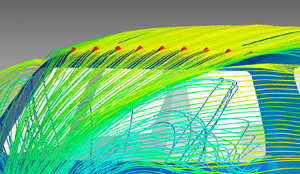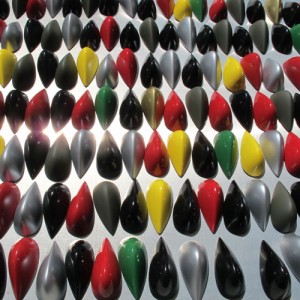Maybe the only invention Leonardo da Vinci hasn’t already imagined is the gas pod, a finely sculpted ceramic bulbosity encased in a shiny urethane shell that increases the fuel efficiency of cars to which it’s attached. That could be because Leonardo never got around to scuba diving. Had he done so, he might have beaten Bob Evans—a lifelong deep-sea diver, inventor, underwater photographer living in Santa Barbara, California—to the punch. By planting nine gas pods onto the rear roof line of his car—a square backed Volvo X70—Evans said, he achieved a small, but dramatic boost in mileage by reducing wind resistance. Trips that used to consume three-quarters of a tank, he said, now burn up only half. That may not be the equivalent of turning water into wine, but it’s significant. Over many trips, the savings add up, both in dollars and tail-pipe emissions.

Evans came up with the GasPod—more technically known as a vortex stabilizer—by extrapolating what he learned from studying the flow of water as it moves over surfaces. It’s been a subject of infinite fascination to Evans, whose genius lies in deciphering the mysterious marriage between form and function.
“Fluid dynamics are really difficult to understand,” he said. “It’s chaos; it’s randomized; it’s so alive.” Evans recalled being struck by the tiny raised bumps that speckled the heads of whales he encountered. “Every little thing has a purpose,” he exclaimed. Evans always exclaims; in fact, he only exclaims. “When I saw similar bumps on lobsters, it blew my mind. If I was God, that’s where I would put them.” Struck by the sudden speed with which seemingly lumbering whales can move—and the startling acceleration of lobsters—Evans wondered what function, if any, those inexplicably random bumps might play.
At that time, he had already begun manufacturing an ergonomically revolutionary new type scuba fin—the Force Fin—designed to better harness the kick power of swimmers’ legs. A designer as well as inventor, Evans’ fins—which are sought after by navies throughout the world—have been displayed at the Museum of Modern Art right next to Charles Eames’ much celebrated chairs. Evans experimented by adding bumps to a prototype fin he tailor-made for industrial deep-sea workers called upon to carry heavy loads. The addition of bumps, he concluded, made a big difference.
Evans was born in Paris, where his father—a combat veteran of World War II—worked as an artist and his mother wrote cookbooks. The family would eventually move to Southern California’s Hermosa Beach, where Evans’ parents—opinionated and determined—emerged as forces to be reckoned with in civic affairs. At an early age, Evans found himself entranced by the life aquatic. The sea would serve as his university, his graduate school, and for decades, his place of employment. In person, Evans is a non-stop collision of curiosity and enthusiasm. A wooly-haired inventor forever in awe, Evans seems constantly bombarded by new, exciting ideas. But he takes pains to point out he’s no engineer. “My engineering degree,” he boasts, “is from watching nature.”
From such observations, Evans learned that resistance—whether wind or water—diminishes as surface area expands. More water, for example, can fit through a wide-nozzle hose than a skinny one. But one can expand the surface area of the same sized hole, he noted, by adding bumps. That’s the theory behind the gas pods.
Evans spent $30,000 to have his idea tested by CD-adapco, an engineering firm specializing in fluid dynamics. That money, Lee said, paid for eight days, four hours, and three minutes worth of excruciatingly detailed computerized modeling. Evans talks with descriptive ease about air being “folded,” “sucked in,” and “braiding.” With the gas pods, his mission is to provide a faster escape route for the air struck by a car zooming through space. The punch line of his modeling study is that they do. The pods—spaced four inches apart and located 10 inches from the lip of the roof—reduced aerodynamic drag by 5 percent when a two-door VW Golf was driven at 65 miles per hour. How that reduction in “drag” translates to better mileage is something Evans is now testing with a select group of volunteer drivers. Those results, he said, are a far cry from final, but range from a four to 19 percent increase in miles per gallon. Speaking personally, he said, “Driving at 60 miles an hour, we went from 19 to 20 miles a gallon to 24.5.” Evans calculated that translated to a savings of $6.19 per tank.

The pods come in loud flashy colors. Some can be permanently glued to the roof. A more expensive model attaches via magnets. Prices currently range from $60 to $100, but those, Evans said, will come down to reflect how much a driver might save in a couple of months.
Aside from the monetary relief, Evans said the pods offer drivers the opportunity do something about climate change.
“People don’t want to be told what to do; they want to do it themselves.” The gas pods, he acknowledged, are a very small fix to an overwhelmingly large problem. But for every gallon of gas not internally combusted, 19.4 pounds of carbon dioxide won’t get into the atmosphere. If 133 drivers reduced their gas consumption by just five percent, that would spare the atmosphere from absorbing enough CO2 to fill a balloon the size of the Sears Tower. If only 2 percent of the two billion cars on the planet’s roads increased their efficiency by just five percent, Evans calculated, they’d save the planet from 650 megatons of carbon dioxide. And that, he noted, just happens to be the same mega-tonnage the federal government hopes to plant into the earth via the costly process of carbon sequestration. “The pod’s not perfect,” he said, “but it’s a step in the right direction.”
But for Evans, it’s clearly just the first step. Already, he’s set his sights on bigger targets. Next on his to-do list is to equip the hulls of ocean tankers, a major source of global pollution, with pods. Already he’s been told it can’t be done. The design of hulls, he was informed, can’t be improved. Naturally it was an engineer, he said, who told him.



